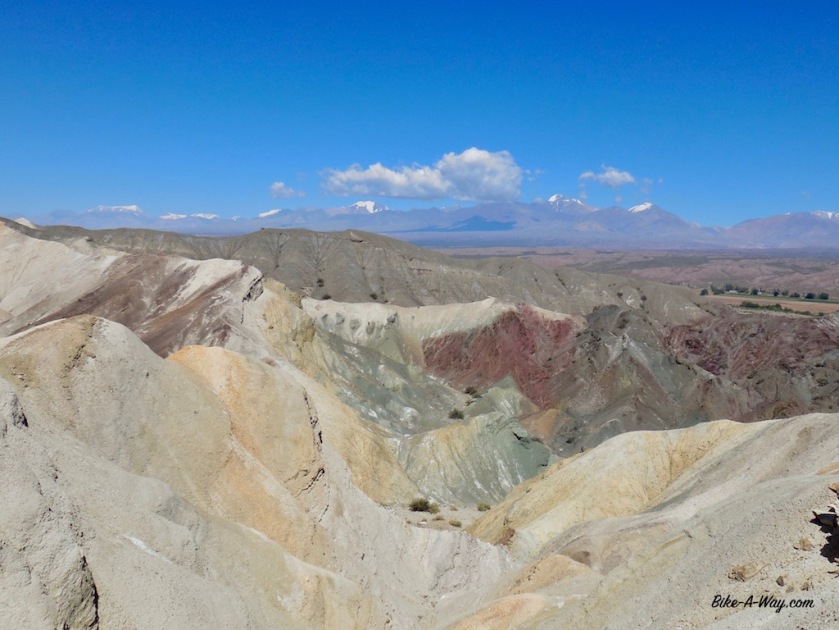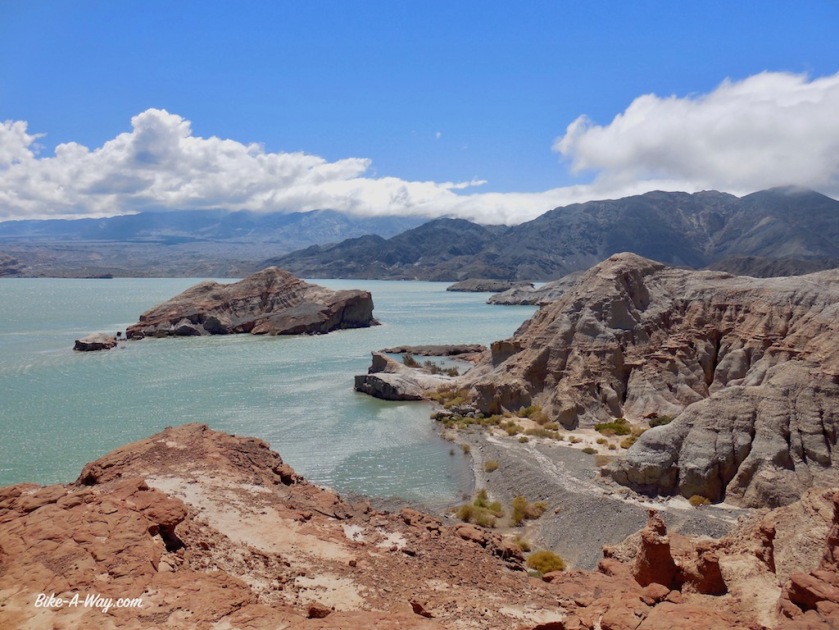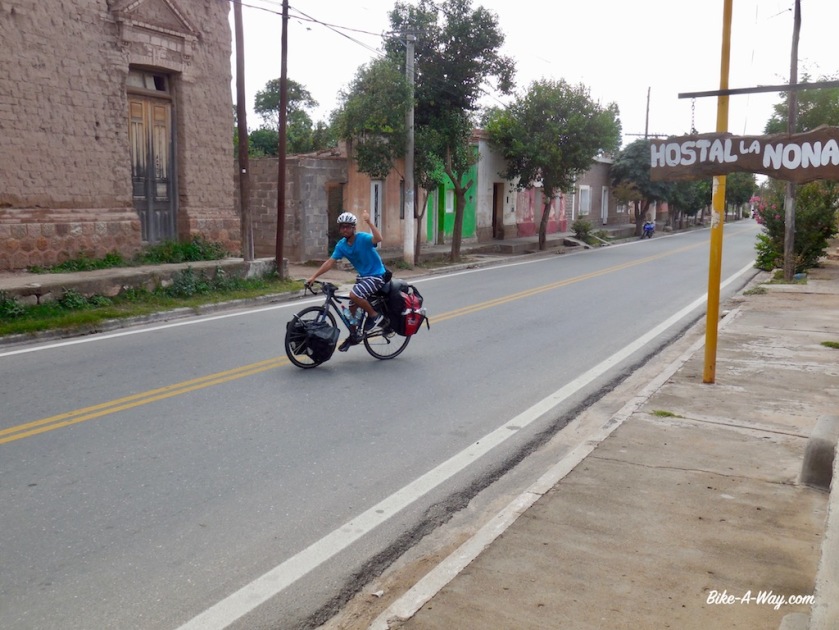Route: Uspallata – Calingasta – Iglesia – Rodeo – San José de Jachal – Villa Union – Chilecito – Alpasinche – Belén
Route nbr 40 between the provincial capitals Mendoza and San Juan will probably not be a big joy to ride, so I chose a smaller option closer to the Andes range, Ruta 149 from Uspallata towards Calingasta, Rodeo and San José de Jachal.
My map suggested the road from Uspallata to Calingasta would be paved all the way. A false claim.
Pretty soon I’m back on gravel.
The map also showed on various points ‘Qhapaq Nan’. I had no clue what it was. Along the road, I learned this means ‘Inca Road’, and I’m now on the southern most section of this historic trail (the Incas’ southern progress was stopped here by the Mapuches).


To my west, I have views of the Cordillera del Tigre with again a bunch of 5.000 + m high mountains.
Unfortunately, Parque Nacional El Leoncito was closed, due to serious damages in the park after the heavy rains.
Proceeding north, the Sierra del Tigre now the east of me, I visit the stunning Cerro El Alcazar.





While having lunch at the ‘plaza’ in Calingasta, I learn from a teacher who’s waiting for the bus to Villa Nueva there wouldn’t be any possibilities to buy provisions there. But she promises to refill my water bottles in the school tomorrow.
On the way in the next day, I meet some German guys who drove a big chunk of the South-American continent with their Paris-Dakar style moto’s the last three months.
They warn me for the upcoming stretch of ripio, saying it was some of the hardest they encountered. They even had to dismount their motor bikes in the loose sand.

I don’t see the teacher back in Villa Nueva, but she told her colleagues I would show up.
Talking way too long with them, and the German guys, it’s already afternoon, and very hot, when I leave Villa Nueva.
I enquired with the teachers whether there wasn’t a small kiosko or anything to buy some bread, but they said there wasn’t. You could only buy alcohol here.
But, on my way out, of ‘town’, there was a small wooden sign outside a shed that claimed they sold food and beverages.
Entering the building, a fragile centenarian was just having his lunch.
He had some basic stuff, like cans of tuna, pasta, olives, …
No bread.
I bought some extra pasta, tuna, onions and dry, tasteless cookies. Then I saw his fridge.
Aaah, “a cold coke please”, I asked.
But indeed, he only had beer in that fridge.
What a shame. I told him he should put some coke in there for passing cyclist.
I would have bought one, and who knows another cyclist will show up on his doorstep later today ?
In the end, he gave me also what was left of his bread, so I was good to go.
Eighty kilometer of very bad road was coming up, he said.
It wasn’t all that bad at first. Lot’s of washboard. Up and down. Some sandy stretches.
But no traffic.
Nothing.
What a good road !
At the beginning of a particularly bad stretch, I was just trying to push my last meters before dismounting, I saw a cyclist coming from the other side.
On a Santos bike ! 🙂
It was John, a Dutchman cycling from Brazil to Santiago de Chile, then flying out to New-Zealand.
We chatted for quite some time. He warned me a stretch of 8 kilometer was coming up. Like a dried out river, full of loose sand and stones. Eight kilometer of pushing.
This was my fourth longer conversation in 24 hours.
Good, but that’s enough socializing for this month 😉
I pitched the tent a bit further on, leaving the hard part for tomorrow.

Having that part behind, I reached the pass (2.655 m) at a place cold Tocota.
Only thing here is a police check point. Reluctantly, they gave me some water. They claimed they didn’t have much themselves.






At the town of ‘Iglesia’, I’m back on asphalt, and there are some shops.
Both my guide book and map claimed I should visit ‘Capilla de Achango’, an old chapel, some three kilometer from the main road, along a bad gravel path.
I went down.
‘If the chapel is closed, you can get the key from the house next door’, the guidebook said.
Not when nobody’s home of course.

In Rodeo, I went to the park headquarters of the Parque Nacional San Guillermo.
It was closed.
Just after Rodeo, at the ‘Dique Cuesta del Viento’, they’ve built a dam in the Rio Jachal, thus creating one of the top windsurfing spots in the world, just at the foot of the Andes mountains. Apparently, in summer wind is blowing almost every day here at speeds upto 120 km/hr. It wasn’t blowing that hard the morning I passed, but the wind sure made me work hard until half way down the road to San José de Jachal. In this town, one should visit the ‘Iglesia Sande Jachal’ with it’s black Madonna.
It was closed.




Since halfway between Rodeo and San José de Jachal, I felt this strange ‘wobble’ in my back wheel. I trust my rims, since they are Belgian made Rigida touring rims, so it had to be the tyre. And sure enough, it was torn for about 20 cm right where it fits in the rim (this is not the tyre I repaired back in Chile, that one is still holding out).
I limped into town. A Maxxis mountainbike tyre was the bast I could get
San José de Jachal is also the place where I have to decide whether I ‘ll make the detour via Parque Natural Provincial Ischigualasto, better known as ‘Valle de la Luna’ and Parque Nacional Talampaya. Both are renowned to be among the most beautiful in Argentina.
BUT, both can be visited under guidance of a ‘guardaparque’ only.
Now, it is claimed you can get a guardaparque on a bike in ‘Valle de la Luna’, but I can see from here they probably don’t have a bike, or it’s broken, or ….
Furthermore, I heard (part of ?) the park is flooded by the heavy rains and can’t be visited.
Nothing of all these question can be confirmed or denied in San José de Jachal, so I decide not to take my chances and ride directly north through the Cuesta de Huaco towards Guandacol and Villa Union, again on Ruta 40.




It’s still rainy season here (till end of March) and almost every evening and night there’s a thunderstorm with a spectacular light show. That’s nice enough as long as there’s not a real storm coming with it, or hail, which I don’t like on the tent.
Some nights, I’m out in the open pampa and my tent with it’s three aluminium poles the highest thing around for kilometers, which makes me worry not to get hit by the lightning.
After the horse flies further south, there are now smaller flies, only a few millimeter long which annoy me. They do bite as well.
And ants.
Zillions of ants. Everywhere. Just before Guandacol, every spot I inspected was even infested with red ants.

I’ve been cycling between beautiful red rocks for a couple of days now, but 40 kilometer after Villa Union, when one starts climbing towards the Cuesta de Miranda, suddenly I spot the first big cacti along the road. It’s like a wild west country here.







Continuing traveling along Ruta 40, I pass Chilecito, Pituil, and cycle into Londres, one of the oldest little towns of the province Catamarca. For the first time since quiet a while it’s raining heavily and when I see a loaded touring bike at the hostel in Londres, I call it a day as well. The bike was from a Japanese cyclist, heading south.
We go for diner together later that night. He’s a university student at the Kyoto university.





This segment of Argentina that you’ve just finished apparently went though without any complications…other than having loose sand and ripio roads. Besides, you met other cyclists which gave you a bit of communication about the roads and I imagine of your own anecdotes about both your adventures. I hope that you continue your trip without any bad experiences. Take care my friend! 🙂
LikeLike
Thanks a lot 🙂
LikeLiked by 1 person